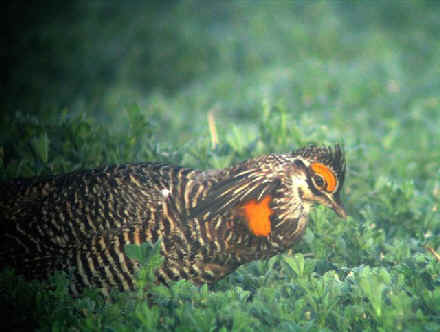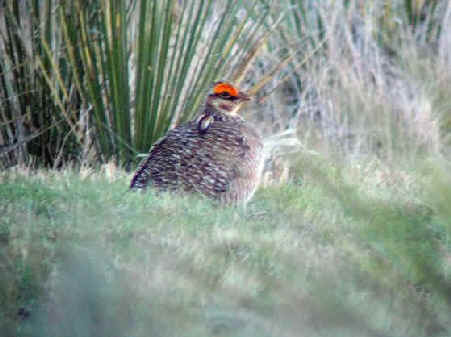 PO
Box 9021, Wilmington, DE 19809, USA
PO
Box 9021, Wilmington, DE 19809, USAE-mail: font@focusonnature.com
Phone: Toll-free in USA 1-888-721-3555
or 302/529-1876
Website: www.focusonnature.com
 PO
Box 9021, Wilmington, DE 19809, USA
PO
Box 9021, Wilmington, DE 19809, USA
E-mail: font@focusonnature.com
Phone: Toll-free in USA 1-888-721-3555
or 302/529-1876
Website: www.focusonnature.com
Grouse
in April
in Colorado, Nebraska
and western Kansas
a collection of
notes
compiled by Armas Hill,
with photographs during Focus On Nature tours
April is an ideal time to observe groups of grouse performing at their leks.
Colorado, and nearby Nebraska and Kansas,
are good places to see as many as 7 species of them.
Links:
Upcoming FONT Birding & Nature Tours in Colorado,
Nebraska, Wyoming, Kansas & Oklahoma

The Dusky
(formerly Blue) Grouse is one of the 7 species of grouse
to be seen in Colorado & nearby Kansas.
The others include the 2 species of Prairie Chickens,
Sharp-tailed Grouse, Greater & Gunnison Sage Grouse,
and White-tailed Ptarmigan.
Information about some of these follows.
(above photo by Alan Brady)
There are 3 species in the "Prairie Chicken Group": the
Greater Prairie Chicken, the Lesser
Prairie Chicken, and the Sharp-tailed Grouse.

There have historically been 3 subspecies of Greater
Prairie Chickens.
In the eastern United States, the subspecies T.c. cupido, called the
"Heath
Hen", occurred formerly in bushy habitat from Boston south to Washington.
It was extirpated on the mainland about 1835. It continued to survive beyond
that on the Massachusetts offshore island of Martha's Vineyard until it was last
reported there in 1932. At that time, the eastern race of the Greater Prairie
Chicken became extinct.
Another race of the species, in coastal Texas, is now very rare. T.c.
attwateri,
the "Attwater's Prairie Chicken" has declined in 30 years from 8,700
individuals in 1937 to 1,070 in 1967. After another 30 years, in 1998, only 56
individuals remained in 3 isolated populations. Even with released
captive-reared birds, that subspecies is severely threatened.
The most wide-ranging of the Greater Prairie Chicken subspecies (and the one
occurring in eastern Colorado and Nebraska), T.c. pinnatus, has declined over much of its
range. The population in the late 1970's was estimated as 500,000. Due to its
being in small isolated populations, the species overall is at considerable
risk.

Greater Prairie
Chickens at their lek at dawn,
photographed during the FONT tour in Colorado in 2009.
The following three photos
are of Greater
Prairie Chickens
where they displayed during an early morning in an alfalfa field.
(These photographs were taken during our April 2005 tour)
.


The Lesser Prairie
Chicken has declined substantially since the European settlement of
the Great Plains. That decline is thought to be over 90% since the 19th Century,
and nearly 80% since the early 1960's.
In 1980, Lesser Prairie Chickens occupied only 8% of their original range (which
was historically throughout the southwest Great Plains, in southeast Colorado,
southwest Kansas, western Oklahoma, northern Texas, and eastern New Mexico).
Now, it is only in small, scattered populations.
The population estimate was about 50,000 birds in about 1980 (from 42,000 to
55,000 in 1979). 20 years later, in 1999, the population was estimated as 10,000
to 25,000, mostly in northwest Texas and Kansas.

These two photos (above & below) are of Lesser Prairie
Chickens
in the early morning at their lek.
(Photographs during the FONT April 05 tour.)

There are 5 subspecies of Sharp-tailed
Grouse. It now occurs in less than half of its original range in 9
U.S. states. It is now extinct in 8 U.S. states where it formerly occurred. In
the northern part of its range (in Canada), it is fairly common.
The Gunnison Sage
Grouse is a newly-described species
of the USA heartland. It is very localized with a range restricted to southwest
Colorado and southeast Utah. It's thought to have formerly been more widespread
(possibly in New Mexico, eastern Arizona, southwest Kansas, and Oklahoma).
Now the bird occurs in 6 or 7 counties of southwest Colorado and a single county
in adjacent southeast Utah. The entire population is estimated at being less
than 5,000 birds, with most (2,500-3,000) in the Gunnison Basin (of Colorado).
Elsewhere populations number less than 300, with fewer than 150 in Utah.
It has disappeared from several population pockets since 1980, with an overall
decline of over 60% in males attending breeding leks in the Gunnison Basin in
the last 50 years.
Formerly considered a subspecies of the more-northerly Sage Grouse (now Greater
Sage-Grouse), Gunnison Sage-Grouse of both sexes have plumages
similar to that species, but are about 30% smaller.

White-tailed
Ptarmigan
A good source for information (such as that above) about
the grouse is the book: "Pheasants, Partridges, and Grouse" by Steve
Madge and Phil McGowan,
published in 2002 by Princeton Univ Press.